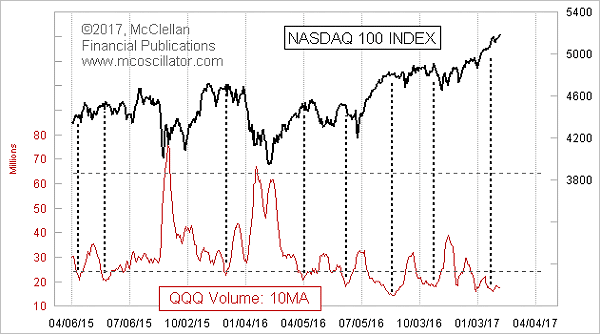When investors get complacent, they do certain things. They show up as bullish in the various surveys. They bid tiny premiums on options, driving down the VIX. They put all of their cash to work, letting money market fund levels get down really low. And they trade tiny volumes on QQQ.
This week’s chart looks at a 10-day simple moving average in the daily trading volume of QQQ, the largest of the ETFs which tracks the Nasdaq 100 Index. Low readings like this are associated with investor complacency, and thus with important price tops.
Volume has been trending lower in recent months, so the static thresholds of “high” and “low” employed in the chart may not be ideal. But there is no question that this is a low reading.
You may also like Jim Bianco: Extreme Readings in the Bond Market
One problem with this analysis technique is that holidays like Thanksgiving and Christmas naturally produce low trading volume, which is not a function of how investors are feeling. So one needs to employ at least a mental filter when examining QQQ volume around those days.
Holiday effects are not an issue at the moment. Instead, low VIX, low worry, and high complacency are producing low QQQ volume. The one-day reading on Feb. 6 was the lowest in the past year if we except holidays. Traders are clearly not very worried about volatility risk, correction risk, and strangely enough, political risk. And if they cannot get any less worried, they can only get more worried. When they do, they’ll likely react in a bad way, meaning prices going lower.
Moments of excitement in the stock market tend to produce high volume in QQQ, and also in other big ETFs like SPY. So big high spikes in the QQQ Volume 10-day MA are good markers of important price bottoms for the stock market. Someday in the future, we’ll get the chance to make such an interpretation as prices drop into an important bottom. But the interpretation task for the moment is to observe that volume numbers are low, and thus top-worthy. This confirms the expectations of an early February top, as explained in our Daily Edition and our twice-monthly McClellan Market Report.
Related Charts
Jul 02, 2015 | May 22, 2014 | Oct 20, 2016 |










